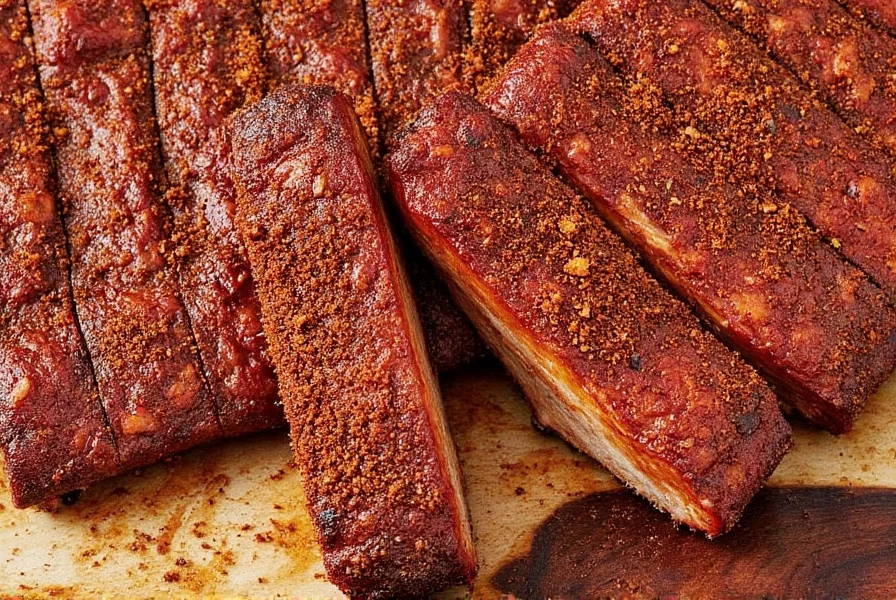Simple Homemade Ribs Rub Recipe for Perfect Flavor
Here's a proven ribs rub recipe that delivers perfect flavor every time. This blend uses pantry staples and works for pork or beef ribs:
- 1/4 cup brown sugar
- 2 tablespoons paprika
- 1 tablespoon garlic powder
- 1 tablespoon onion powder
- 1 tablespoon chili powder
- 1 teaspoon black pepper
- 1 teaspoon cumin
- 1 teaspoon salt
- 1/2 teaspoon cayenne pepper (optional for heat)
Mix all ingredients together. Apply generously to ribs before cooking. This recipe makes enough for 2-3 racks of ribs.
Understanding Key Ingredients in Ribs Rub Seasoning
Each ingredient serves a specific purpose for optimal flavor and texture:
- Brown Sugar: Creates caramelized crust (bark) and balances spice with sweetness.
- Paprika: Provides vibrant color and smoky depth (use smoked paprika for richer flavor).
- Garlic and Onion Powder: Enhance savory notes without overpowering meat.
- Chili Powder: Adds complex heat; adjust quantity based on preference.
- Cumin: Earthy foundation that complements smoky barbecue flavors.
- Salt: Essential for flavor enhancement and moisture retention.
- Cayenne Pepper: For extra heat; use sparingly if you prefer mild seasoning.

Pro Tips for Applying Ribs Rub Seasoning
Follow these steps for maximum flavor penetration and crust formation:
- Measure Precisely: Use measuring spoons for consistent results. Too much sugar burns easily; too little salt lacks flavor depth.
- Apply Generously: For a full rack of ribs (2-3 lbs), use 2-3 tablespoons of rub. Rub thoroughly with hands to cover all surfaces.
- Rest Time: Let ribs sit with rub for 30 minutes at room temperature or up to 24 hours refrigerated. This allows salt to break down proteins for deeper flavor.
- Remove Membrane: Always peel off the silver skin from the bone side before applying rub for better penetration and tenderness.
- Cooking Method: Dry rubs work best with low-and-slow smoking (225-250°F for 4-6 hours). Avoid wet rubs for proper bark formation.
Choosing the Best Store-Bought Ribs Rub
When selecting commercial rubs, prioritize these factors:
- Ingredient Quality: Avoid artificial additives or excessive fillers. Look for recognizable spices as first ingredients.
- Flavor Profile: Match to your preference: sweet/smoky, spicy, or traditional.
- Price Value: Quality rubs typically cost $0.50-$0.70 per ounce.
| Brand | Flavor Profile | Key Ingredients | Price per oz | Best For |
|---|---|---|---|---|
| Stubb's Original Rub | Classic Sweet & Smoky | Brown sugar, paprika, garlic, onion, spices | $0.50 | Beginners, general use |
| Deadwood Spice Co. Ribs Rub | Spicy & Bold | Chili powder, cayenne, cumin, brown sugar | $0.60 | Heat lovers, competitions |
| Big Bob Gibson's Barbecue Rub | Traditional Southern | Paprika, black pepper, garlic, salt | $0.55 | Pork ribs, authentic taste |
| Franklin Barbecue Rub | Smoky & Complex | Smoked paprika, coffee, brown sugar, spices | $0.65 | Smoked ribs, gourmet applications |
Frequently Asked Questions
How much rub should I use per rack of ribs?
For a standard full rack (2-3 lbs), use 2-3 tablespoons of rub. Apply evenly to all surfaces until the meat is completely covered. This ensures consistent flavor without waste.
Should I use dry rub or wet rub for ribs?
Dry rubs are preferred for ribs as they create the ideal crispy bark during smoking or grilling. Wet rubs (with liquids like oil or vinegar) can prevent proper crust formation. If needed, apply a thin layer of mustard first to help dry rub adhere better.
How long should I let rub sit before cooking?
Minimum 30 minutes at room temperature for flavor penetration. For best results, refrigerate for 4-24 hours. The salt in the rub will break down proteins, allowing deeper flavor absorption and tenderizing the meat.
Can I use the same rub for pork and beef ribs?
Yes, but adjust proportions. Beef ribs handle bolder spices better, so increase cayenne or coffee powder. Pork ribs benefit from sweeter profiles, so increase brown sugar slightly. Always remove membrane from both types before applying rub.
Do I need to remove the membrane from ribs before applying rub?
Yes, absolutely. The silver skin membrane blocks flavor penetration and becomes tough when cooked. Use a butter knife to lift one corner, then peel it off completely with paper towels for grip. This step is critical for tender, flavorful ribs.
Should I reapply rub during cooking?
Generally no. The initial application creates the flavorful crust. Reapplying during cooking can disturb bark formation. For 3-2-1 method (3 hours smoke, 2 hours wrapped, 1 hour finish), you may lightly dust during the final hour if desired, but this is optional.
Master Your Ribs Rub Game
With this precise recipe and expert tips, you can transform ordinary ribs into restaurant-quality barbecue. Remember: accurate measurements, proper resting time, and membrane removal are the secrets to perfect flavor. Whether you make your own rub or choose a store-bought option, focus on quality ingredients and application technique. Now go create unforgettable ribs that will have everyone asking for your secret recipe!










 浙公网安备
33010002000092号
浙公网安备
33010002000092号 浙B2-20120091-4
浙B2-20120091-4